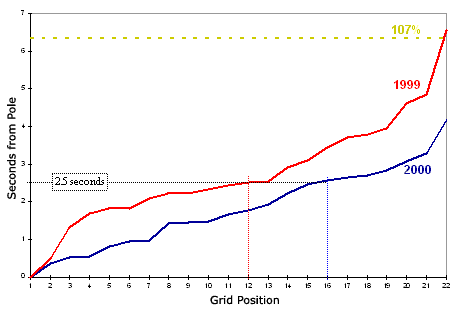|
| |||
 |
Statisitical Analysis: Back to 1999 | ||
| by Will Gray, England | |||
|
The first qualifying session of a new season is where everyone comes clean. There's no running without ballast, no running without competition - no deception. Times here are times, not just numbers. Everyone's out for the same thing - the fastest time around the circuit. So how did they all do?
Well, as bleary eyes opened in the UK, the first glance at the grid in the morning paper said it all - Welcome to 1999! One year on, and we're back where we started, with the top five on the grid made up of exactly the same drivers as in Australia last year. Same men, and similar cars, with McLaren topping the times once again, but there were shufflings in the rest of the pack and all is not quite what it seemed. It looked like it was all going McLaren's way yet again, but the times told a different story for the start of 2000. Last year's gap between Hakkinen and Schumacher was 1.3 seconds. One year on, that is down to 0.5 seconds (with excuses and presumptions of even lower). Ferrari, then, appear closer to McLaren - as was expected this year, with the off-season time used for development rather than for adjusting to new rules. Schumacher claims his car is so fast that he's a dead cert for the championship, but in practice he looked ragged, driving to the limit of his car and then some. If he had not come off the road, he would probably have taken the pole, but he appears not to have found the limit of the Ferrari yet. Be assured, he soon will do! The other expectation was that the closing pack would be closer than ever. Indeed, in 1999 the top twelve cars were covered by 2½ seconds, whilst this year that time took in the top sixteen. This can be seen in the first graph, which shows each grid position from 2 to 22, and the number of seconds off pole that position was last year and this. The fact that the 2000 line is constantly below the 1999 line shows that the grid has closed up, and again the lack of new rules appears to be a good thing for the competition. The overall improvements made on last years' positions are shown in the black and white graph. There appear to be two distinct humps - one in the top six grid positions, and one in the rear of the grid. Looking at Pole position versus grid slot two, we can see David Coulthard closed on Mika in Australia this year. However, more importantly, the following pack, as predicted, have closed up to the McLarens - by about one second. The size of this overall improvement, though, is not grid-universal, and although the midfield has closed on McLaren, it is only by between half and point eight of a second. Again, this is no surprise, as teams such as Sauber and Benetton do not have the budget of the teams higher up the grid. Meanwhile, the cars at the rear of the grid have made the most gigantic steps - up to 1½ seconds in some cases (ignoring Marc Gene's disastrous performance in last year's Australian race!). Yet again this was expected, as these teams, who are simply understaffed and very underfunded compared to the top runners, have now had time to catch up. So we see that the whole grid has bunched up (which begs the question of why the FIA constantly want to change the rules!), but there has also been movement within it. Although the front of the grid was, row-by-row, entirely as predicted this season, behind the top six there were plenty of surprises. As expected, Arrows didn't fly to the top of the grid (at least, not the Orange Arrows), as this time they had to carry the ballast weight they had left off in testing. However, their times in 12th and 13th places bode well for the rest of the season. It is clear that adding the ballast has slowed them down, and that suggests they have a significant amount of it on-board to play with. The car, then, is much improved, and Pedro De La Rosa's time was a whole 2 seconds closer to pole position than he managed in Australia in 1999 - that's a larger improvement than the midfield have made, and has seen them make a huge jump up the field. BAR are another team to have bucked the midfield trend. With the help of their all-new Honda engine, they are now on average two seconds off the pace - that's one point two seconds closer to pole than last year. So the first final qualifying can tell you much about the season ahead and, if you believe the figures, the grid has closed up and the races will be much closer. On top of this, some teams have improved more than most, and that has seen two back of the grid teams become the new hopefuls. Should be a good season then. Roll on Brazil!

|
| Will Gray | © 2000 Kaizar.Com, Incorporated. |
| Send comments to: gray@atlasf1.com | Terms & Conditions |
